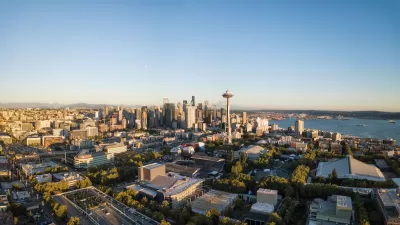It’s time to rewrite California’s building and planning codes for the 21st century, says architect Mark Hogan.

California's obstacles to addressing climate change and the housing shortage include its own code, a piece in BOOM argues.
Layers of code create what Hogan calls a "hairball"—a term borrowed from programming—in which, ultimately, "each bit of code can be used to stop another from doing its work." He writes:
Some of California’s own largest policy initiatives are at odds with each other … Reducing VMT requires density, but density is nearly impossible to achieve while constructing net-zero buildings.
To tease out some of the threads making up the hairball of code, Hogan tackles the history of planning, zoning, and building codes across California since the late 19th century. Though they generally arose independently in each city, early codes were defined by the times: they sought to counter the conditions of early American cities through ample space, separation from industry, and, of course, racist exclusion.
Though planning goals have changed, in many cases, codes have not kept up. Now, Hogan urges, "[in order to] create affordable cities, responsive to a changing climate and prudent with limited natural resources, we may need to rewrite the rules from scratch with a new set of goals in mind."
For one, he suggests semi-dense urban development—think low-rise apartments or in-law units:
Disallowing this kind of gentle medium density in the name of preserving neighborhood character does a disservice to those who arrived here or were born too late to afford a single-family home within commuting distance of their jobs. It also fails to recognize that making communities more walkable and sustainable will improve neighborhood character over time, not diminish it.
FULL STORY: Re-Coding Planning

Depopulation Patterns Get Weird
A recent ranking of “declining” cities heavily features some of the most expensive cities in the country — including New York City and a half-dozen in the San Francisco Bay Area.

California Exodus: Population Drops Below 39 Million
Never mind the 40 million that demographers predicted the Golden State would reach by 2018. The state's population dipped below 39 million to 38.965 million last July, according to Census data released in March, the lowest since 2015.

Chicago to Turn High-Rise Offices into Housing
Four commercial buildings in the Chicago Loop have been approved for redevelopment into housing in a bid to revitalize the city’s downtown post-pandemic.

Twin Cities Trains Move to Fewer Cars, Higher Frequency
Headways will drop from 15 minutes to 12 minutes.

DC Bikeshare System Breaks Ridership Record
Capital Bikeshare users took over 20,000 rides on one day in March.

EV Infrastructure Booming in Suburbs, Cities Lag Behind
A lack of access to charging infrastructure is holding back EV adoption in many US cities.
Barrett Planning Group LLC
City of Cleburne
KTUA Planning and Landscape Architecture
HUD's Office of Policy Development and Research
Mpact Transit + Community
HUD's Office of Policy Development and Research
City of Universal City TX
ULI Northwest Arkansas
City of Laramie, Wyoming
Urban Design for Planners 1: Software Tools
This six-course series explores essential urban design concepts using open source software and equips planners with the tools they need to participate fully in the urban design process.
Planning for Universal Design
Learn the tools for implementing Universal Design in planning regulations.






















